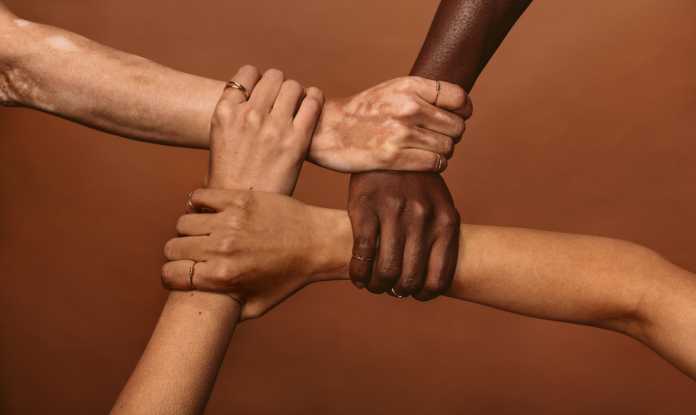Many 2020 Democratic presidential candidates have emphasized the role of historical and contemporary discrimination in creating and perpetuating disparities between Black and white Americans. This discourse underscores the critical responsibility of all public voices—including researchers, policymakers, practitioners, and journalists—to consistently use their platforms to call out the root causes of racial disparities.
When we name the historical and contemporary policies and practices that create and maintain racial disparities, we can challenge harmful stereotypes and narratives that shape the way people of color are perceived and treated.
Making this consistent practice can help produce effective solutions by rightfully shifting responsibility for disparate outcomes from people of color to systems of oppression.
Contextualizing disparities challenges harmful narratives
America’s dominant cultural lens and narrative center on white people and portray the country’s past primarily as a story of social innovation and progress.
Within this narrative, modern problems like poverty and crime are individual and communal failings, and, by extension, racial disparities are indicative of poor choices or behavioral patterns, not historical and continued discrimination. This narrative minimizes or erases the impact of the human trafficking and bondage of people of African descent and the subsequent terrorizing and humiliation of Black people through violence, the Black Codes, and Jim Crow. And it implicitly perpetuates the belief that white people are doing better because they are inherently better or are working harder, laying the bedrock for white supremacy.
“We know that the generational theft of the descendants of slaves is a part of why everything from housing to education to health to employment basically puts us in two different countries.” —Mayor Pete Buttigieg
The historical context of racial disparities in every domain—health, homeownership, education, and beyond—reveals a more accurate national narrative in which government-sanctioned policies and practices have facilitated the upward mobility of white Americans and created barriers to mobility for Black Americans.
Policies—more than choices, culture, or genes—explain disparate outcomes because race has no biological basis and was created solely to justify and facilitate systemic oppression.
By consistently providing context, we can help shape a new narrative that indicts the systems that created injustices, rather than the people oppressed by them.
Robust narratives can help challenge biases
Narratives are reinforced through popular culture, the news media, and political rhetoric, which subtly confirm or challenge our biases (PDF) about people of color.
We all hold biases, and whether or not we consciously subscribe to them, they influence how we perceive and treat others. Research shows that negative racial biases may be expressed as outright racism or lead to discriminatory treatment of people of color in hiring (PDF), education (PDF), and the criminal justice system.
Placing disparities in their rightful context can help challenge these biases by shifting blame away from individual people and communities of color. For example, researchers may report higher arrest rates among Black men than among white men. Taken at face value, these statistics may confirm racist stereotypes of Black men as violent and prone to criminality.
But if we discuss the role of punitive policing (PDF) (such as stop and frisk and racially discriminatory drug laws) and policies that have concentrated Black men in poor neighborhoods where the risk for offending and arrest is higher (such as redlining and the construction of segregated public housing) in creating these disparities, we can probe people to question the stereotypes they hold.
Robust narratives facilitate effective solutions
[Racism] is not just an issue that started yesterday.… We have systemic racism that’s eroding our nation from health care to the criminal justice system. —Senator Cory Booker (D-NJ)
When faced with any racialized problem— such as gentrification, disenfranchisement (PDF), police brutality, or job discrimination—identifying effective solutions depends on properly diagnosing root causes. Without context, however, we may fail to portray the breadth of factors that drive the disparity or preclude ourselves and our audiences from learning from past mistakes. This can lead to the introduction of ineffective—or even harmful—policy solutions.
Using the example on racial disparities in arrests, without the context discussed above, one could conclude that Black neighborhoods and Black people need more surveillance and tougher responses to crime.
But within the context of structural racism, we can consider systemic reforms that acknowledge and remedy the historical and contemporary roots of crime, such as decriminalizing marijuana, investing in communities of color, and increasing local economic development (PDF), which show promise in breaking the cycle of criminalization, poverty, and crime.
By consistently placing racial disparities in their historical context, we can push ourselves and our audiences to learn about the specific racist policies, practices, and systems that must be dismantled and replaced in order to close these gaps.
Why isn’t this already common practice?
Too often we present racial disparities as bare statistics and at best, give a vague nod to “structural racism” or “structural barriers” as sufficient explanations for racial gaps. To change our practices, we must acknowledge the reasons why we tend to avoid including this discussion in our work in the first place.
Talking honestly about racism carries risks for public-facing individuals and organizations, whose status and finances depend on the perceptions of funders, audiences, and current and prospective employees.
Naming the structural causes of racial disparities can make some uncomfortable and drive them away. Unfortunately, many people refuse to grapple with the racialized history of the United States, especially if they benefit from white supremacy.
People may misconstrue calls to name white supremacy and oppression as threats to their personal identity, history, or economic standing. Facing America’s racist past also runs contrary to American exceptionalism and oft-professed values of liberty and justice.
Naming the policies and systems responsible for racial disparities can pose an economic risk for organizations, especially if they draw funding from organizations created to build white power and wealth.
Well-intentioned public voices may also shy from discussing the structural roots of disparities to avoid appearing biased or out of fear of lacking necessary knowledge to properly discuss these issues, opting instead to leave the discourse to “experts.”
Some may fear backlash from misrepresenting the history and experiences of people of color. It’s important that we approach these issues with informed thoughtfulness, but abandoning the discussion altogether creates a void that perpetuates harmful narratives and prevents finding solutions.
What does this look like in practice?
Making it standard practice to contextualize racial disparities is critical to addressing the root causes of inequity.
The federal government helped create the racial divide in this country through decades of active, state-sponsored discrimination, and that means the federal government has a responsibility to fix it. —Senator Elizabeth Warren (D-MA)
Public voices have perpetuated harmful narratives, so we have a responsibility to actively deconstruct them. This requires careful consideration not only of the intergenerational effects of racial discrimination but also of how a person’s race intersects with other aspects of their identity, such as class, gender, and sexual orientation.
Many racial justice organizations—such as Advancement Project, Race Forward, and Color of Change—have rooted their work to close disparities in its historical context for decades, and their approach should serve as beacon for all who share the same goal.*
Given the complexity of the subject matter, exemplary discussions of this topic can be useful:
- Ta-Nehisi Coates’s acclaimed article on reparations
- a recent New York Times article on Black homelessness in Los Angeles
- an Urban Institute brief on African American economic security and a report on increasing economic opportunity for young men of color
Research that documents connections between modern-day disparities and discriminatory policies, like The Color of Wealth and The Color of Law, can serve as excellent references for our own work. Toolkits can help researchers incorporate a racial and ethnic equity lens into their work. Organizations in other fields should provide similar guidance.
Addressing persistent equity gaps will require more than changing the way public voices contextualize disparities. It requires reconsidering our values, turning them into action, and investing in the assets and leadership of communities of color. But this is an important step in the right direction.
*This sentence was added to better reflect the work of racial justice organizations in this space (updated 3/6/20).
This blog post was originally published on Urban Wire, the blog of the Urban Institute.
About the Authors
 Natalie Spievack is a research analyst in the Income and Benefits Policy Center at the Urban Institute. Her work focuses on advancing equity for low-income youth and youth of color from birth through higher education and careers. She has studied efforts to increase economic opportunity for young men of color, child care and early childhood education, youth employment, and postsecondary education and training programs. She has experience in qualitative and quantitative data collection and analysis, large-scale program evaluation, and providing technical assistance to programs. Spievack graduated with honors from the University of Wisconsin–Madison, where she earned a BA in political science and economics.
Natalie Spievack is a research analyst in the Income and Benefits Policy Center at the Urban Institute. Her work focuses on advancing equity for low-income youth and youth of color from birth through higher education and careers. She has studied efforts to increase economic opportunity for young men of color, child care and early childhood education, youth employment, and postsecondary education and training programs. She has experience in qualitative and quantitative data collection and analysis, large-scale program evaluation, and providing technical assistance to programs. Spievack graduated with honors from the University of Wisconsin–Madison, where she earned a BA in political science and economics.
 Cameryn Okeke Cameryn is a senior program associate who loves space—not the type that astronauts live in; but the everyday spaces and loving connections that liberate them. Being the child of an immigrant and the inheritor of the legacy of U.S. chattel slavery, Cameryn is obsessed with what it takes to make public space safe, nurturing, and inclusive. At Vera, Cameryn builds projects centered around community flourishing, participatory design, and nurturing accountability. Their current project focuses on disrupting punitive narratives, building community-rooted safety plans, and advocating for deep investment in community nurturers. Prior to coming to Vera, Cameryn was a research associate at the Urban Institute, leading research on various projects on racial justice, community safety, and creative placemaking. Cameryn sees their life’s work as dismantling oppressive structures and designing brave inclusive spaces while building power with the intentionally silenced: Black queer women, nonbinary people, and trans people. Cameryn earned their master’s in bioethics with a concentration in public policy and safety from the Johns Hopkins School of Public Health and a holds a BA from the University of Chicago.
Cameryn Okeke Cameryn is a senior program associate who loves space—not the type that astronauts live in; but the everyday spaces and loving connections that liberate them. Being the child of an immigrant and the inheritor of the legacy of U.S. chattel slavery, Cameryn is obsessed with what it takes to make public space safe, nurturing, and inclusive. At Vera, Cameryn builds projects centered around community flourishing, participatory design, and nurturing accountability. Their current project focuses on disrupting punitive narratives, building community-rooted safety plans, and advocating for deep investment in community nurturers. Prior to coming to Vera, Cameryn was a research associate at the Urban Institute, leading research on various projects on racial justice, community safety, and creative placemaking. Cameryn sees their life’s work as dismantling oppressive structures and designing brave inclusive spaces while building power with the intentionally silenced: Black queer women, nonbinary people, and trans people. Cameryn earned their master’s in bioethics with a concentration in public policy and safety from the Johns Hopkins School of Public Health and a holds a BA from the University of Chicago.
Disclaimer: This article contains sponsored marketing content. It is intended for promotional purposes and should not be considered as an endorsement or recommendation by our website. Readers are encouraged to conduct their own research and exercise their own judgment before making any decisions based on the information provided in this article.

































































